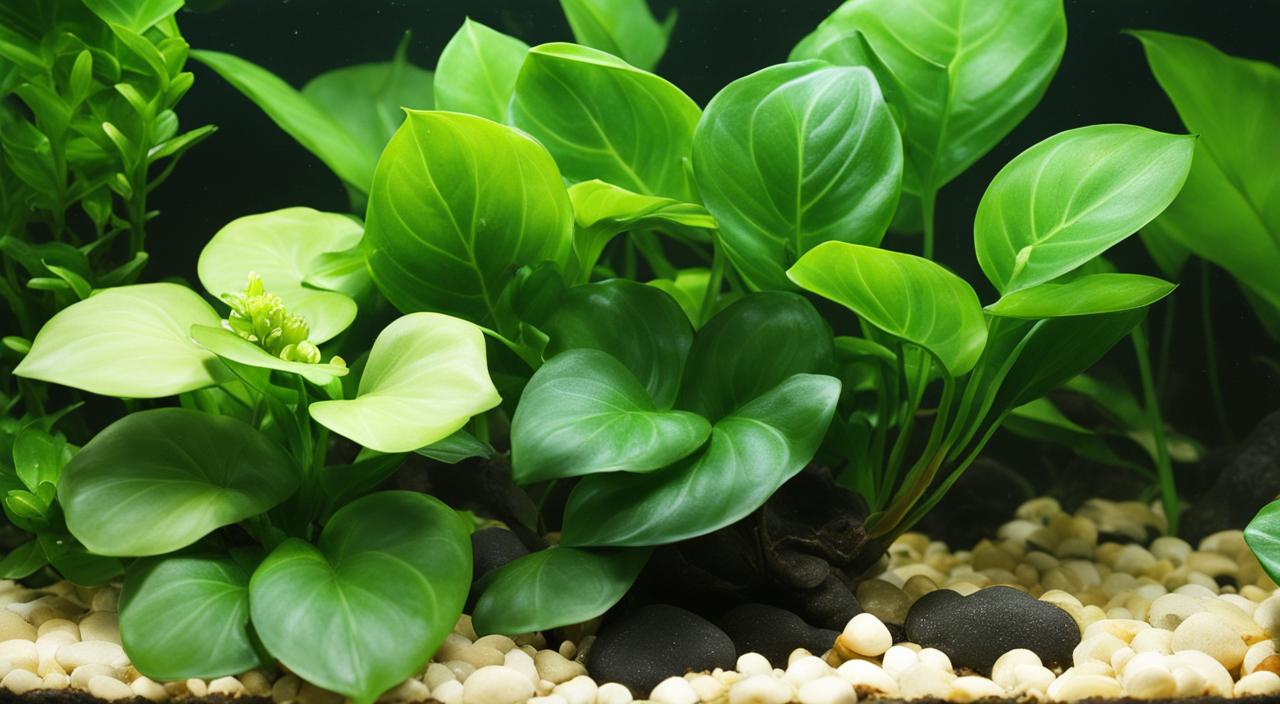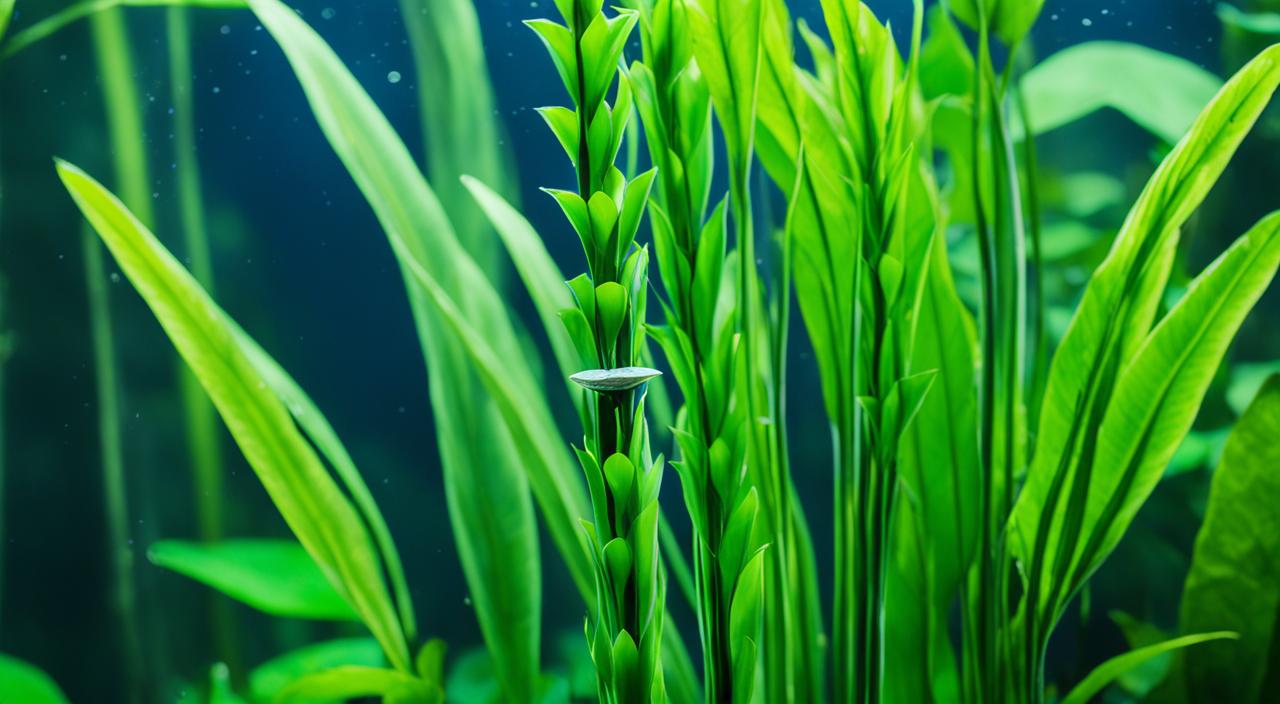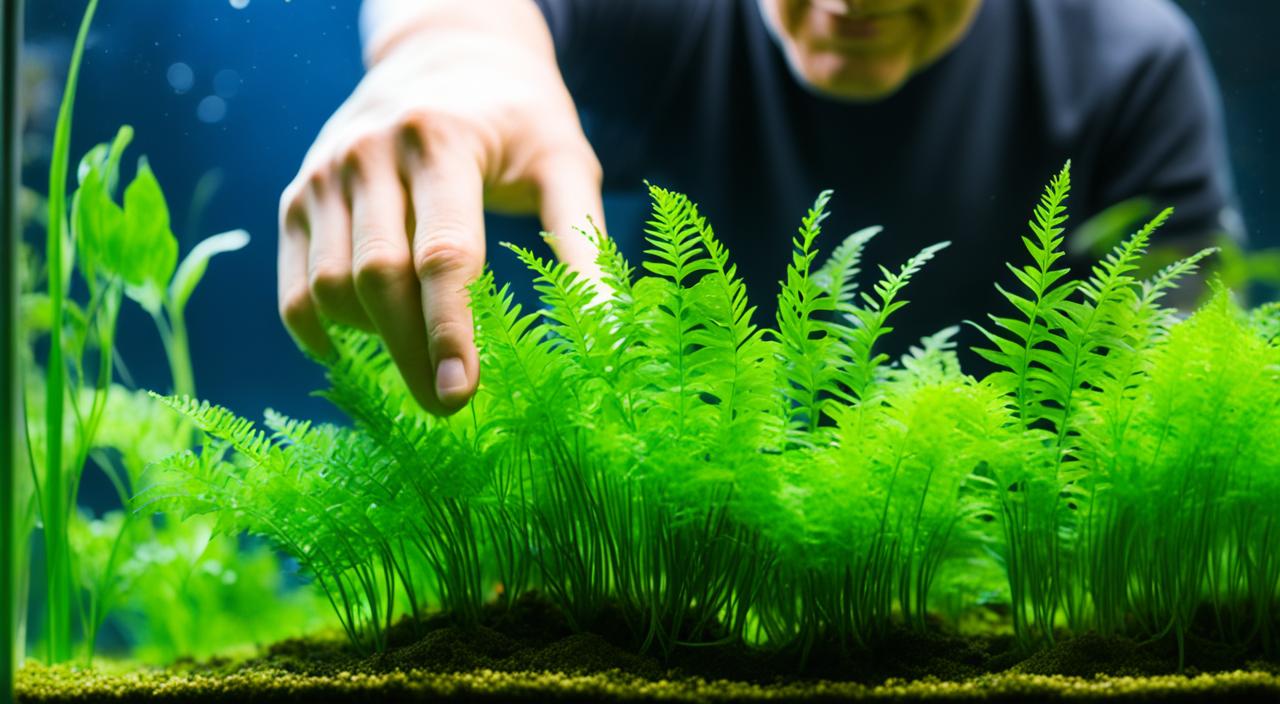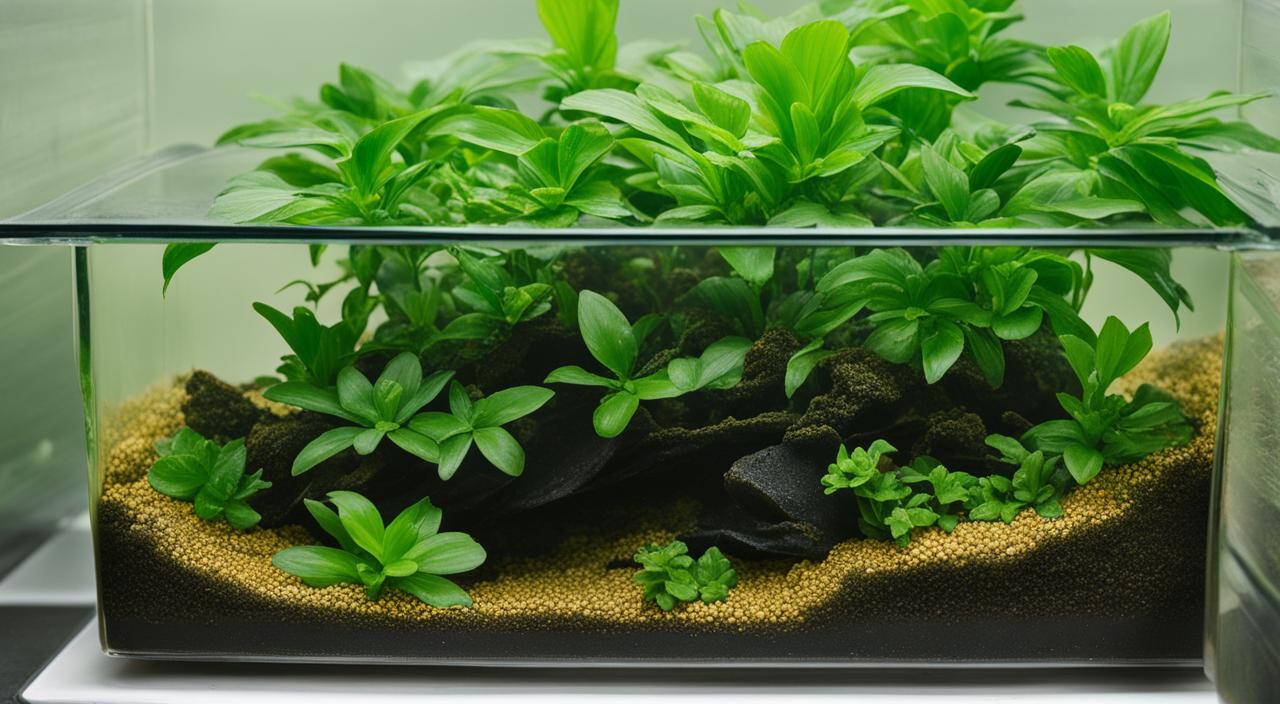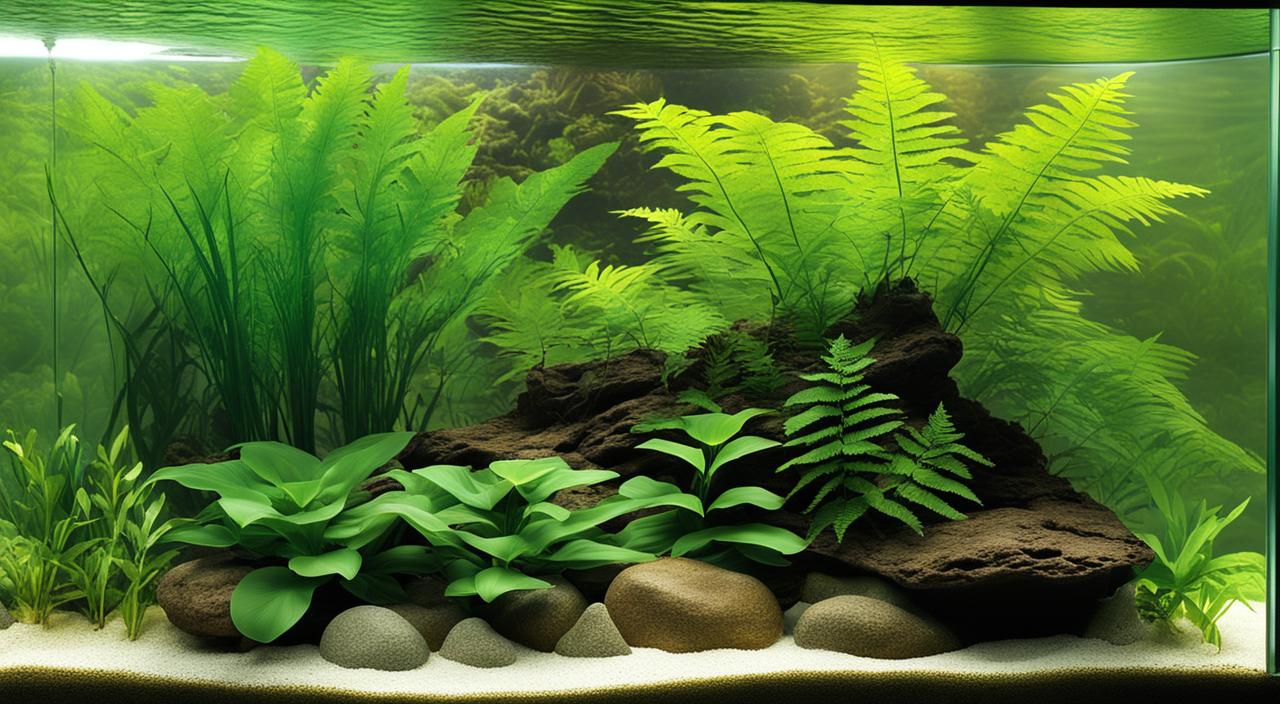In this article, I will guide you through the world of Anubias Nana, also known as Anubias barteri var. nana. This popular variety of Anubias plants is a favourite among aquarium enthusiasts due to its low-light requirements and easy care. Whether you’re a beginner or an experienced hobbyist, Anubias Nana can be a beautiful addition to your aquatic setup.
Key Takeaways:
- Anubias Nana, or Anubias barteri var. nana, is a low-light aquarium plant that is easy to care for.
- It is a slow-growing plant that can be placed in the midground or background of your aquarium.
- Anubias Nana is native to West Africa and thrives in slightly acidic to neutral water conditions.
- It can be attached to rocks or driftwood, and its broad leaves provide shelter for fish.
- Good tank mates for Anubias Nana include tetras, rasboras, gouramis, and plecos.
Brief Overview Of Anubias Nana (Anubias barteri var. nana)
Anubias Nana is a dwarf variant of the Anubias plant, known scientifically as Anubias barteri var. nana. This slow-growing aquarium foliage is highly sought by beginners for its ease of care and hardiness. Anubias Nana can thrive in both aquariums and terrariums, whether submerged or emersed. Its slightly longer stems, compared to other Anubias varieties, make it suitable for placement in the midground and background of aquariums.
| Characteristic | Anubias Nana (Anubias barteri var. nana) |
|---|---|
| Scientific Name | Anubias barteri var. nana |
| Common Names | Anubias Nana, Dwarf Anubias |
| Origin | West Africa |
| Height | 5-15 cm (2-6 inches) |
| Growth Rate | Slow |
| Colour | Dark green leaves |
| Aquarium Placement | Foreground to midground, often attached to rocks or driftwood |
| Water Type | Freshwater |
| pH | 6.0 – 7.5 |
| Care Level | Easy |
| Light Requirements | Low to moderate. LUX: 500-2000, PAR: 10-40, Kelvin: 5000-7000K for optimal growth and color. |
| CO2 Requirements | Not necessary but can benefit from CO2 supplementation |
| Temperature | 22-28°C (72-82°F) |
| Flow Rate | Low to moderate. Prefers gentle water movement. |
| Propagation | Rhizome division. Cut the rhizome with a sharp knife or scissors, ensuring each piece has a few leaves. |
| Feed Type | It is not necessary but can benefit from CO2 supplementation |
Origins And Habitat
Anubias Nana, also known as Anubias barteri var. nana, is a plant native to West Africa. It can be found growing in rivers, streams, and marshes in this region. In its natural habitat, Anubias Nana is typically attached to rocks or driftwood, with the rhizome securely anchored. This plant has adapted to low-light conditions and can thrive in a variety of aquatic environments.
To give you a visual representation of Anubias Nana’s natural habitat, take a look at the image below:
As seen in the image, Anubias Nana grows along the edges of a serene river, with its lush green leaves adding a touch of natural beauty to the surroundings. This plant’s ability to flourish in West Africa’s diverse aquatic ecosystems makes it an excellent choice for aquarists worldwide.
| Origins | Habitat |
|---|---|
| West Africa | Rivers, streams, marshes |
Morphological Characteristics
Anubias Nana, also known as Anubias barteri var. nana, is characterized by its broad, lance-shaped leaves that are a deep shade of green. These leaves are thick and leathery, which protects herbivorous fish that may try to nibble on them. The sturdy nature of Anubias Nana’s leaves makes it a resilient aquarium plant, ensuring it can withstand various conditions and remain visually appealing.
In addition to its distinct leaf shape and colour, Anubias Nana is available in several varieties, each offering unique leaf sizes and shapes. Aquarists can select from a range of Anubias Nana varieties, enabling them to create a captivating and diverse aquatic display. These variations add aesthetic variety to aquarium setups and allow aquarists to choose the Anubias Nana variety that best suits their preferences and design goals.
Placement And Lighting
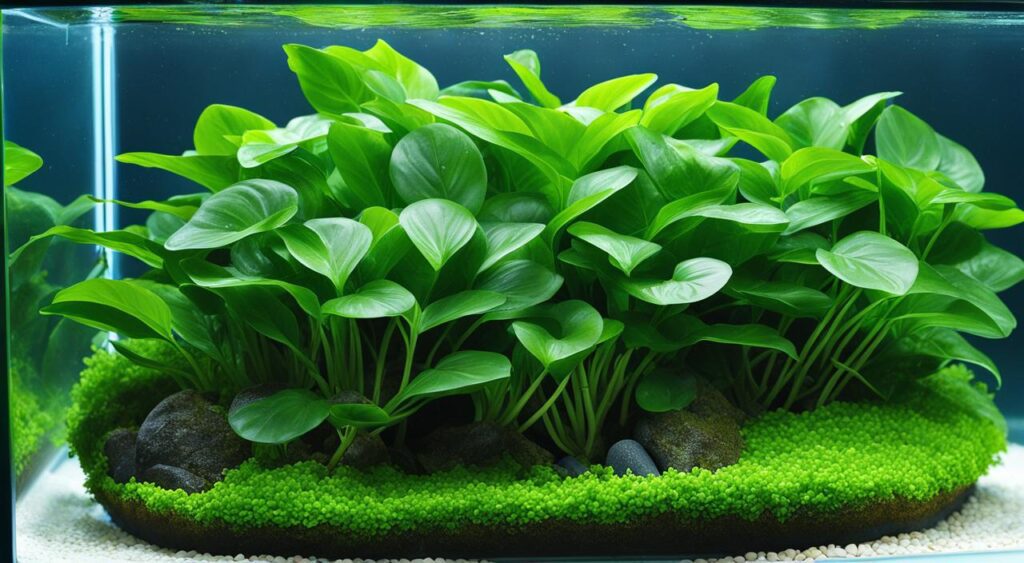
Anubias Nana, also known as Anubias barteri var. nana, is a versatile low-light plant that can adapt to a variety of lighting conditions. This makes it an excellent choice for aquariums with limited light availability. Whether you have a tank with low-intensity lighting or prefer a natural-looking setup with shaded areas, Anubias Nana can thrive and contribute to the overall aesthetic of your aquarium.
Regarding placement, Anubias Nana can be positioned in either the midground or the background of your tank. Its compact size and attractive foliage make it an ideal addition to these areas. To enhance the visual appeal, you can attach the plant to rocks, driftwood, or other hardscape elements, creating a natural and visually appealing setup.
However, it’s crucial to avoid burying the plant’s rhizome when attaching it to a surface. Burying the rhizome can lead to rotting and damage to the plant. Instead, ensure the rhizome is left exposed or securely attached to the surface using aquarium-safe materials such as fishing lines or plant-friendly adhesive.
What Are Good Tank Mates?
Anubias Nana, also known as Anubias barteri var. nana, is a peaceful plant that can coexist harmoniously with a wide range of fish species in your aquarium. When selecting tank mates for Anubias Nana, it is essential to consider their size, temperament, and dietary preferences to ensure a compatible and thriving aquatic community. Here are some excellent tank mates that can cohabitate well with Anubias Nana:
Good Tank Mates
- Tetras
- Rasboras
- Gouramis
- Plecos
- Small to medium-sized community fish
- Dwarf cichlids
- Some shrimp species
These tank mates are generally peaceful and have compatible environmental requirements, making them suitable companions for Anubias Nana. They can add vibrant colours and diverse behaviours to your aquarium, creating an aesthetically pleasing and balanced underwater ecosystem.
Fish Species To Avoid
While Anubias Nana can peacefully coexist with many fish species, some fish are incompatible due to their dietary preferences or aggressive behaviour. It is important to avoid keeping herbivorous fish species with Anubias Nana, as they may nibble on the leaves and damage the plant. Here are some fish species to avoid:
- Dwarf gouramis
- Goldfish
- African cichlids
- Silver dollars
- Herbivorous catfish
These fish species have a higher likelihood of causing damage to Anubias Nana. Choosing tank mates with similar dietary requirements and behaviours is advisable to ensure a harmonious and thriving aquarium environment.
Feeding (Fertilization)
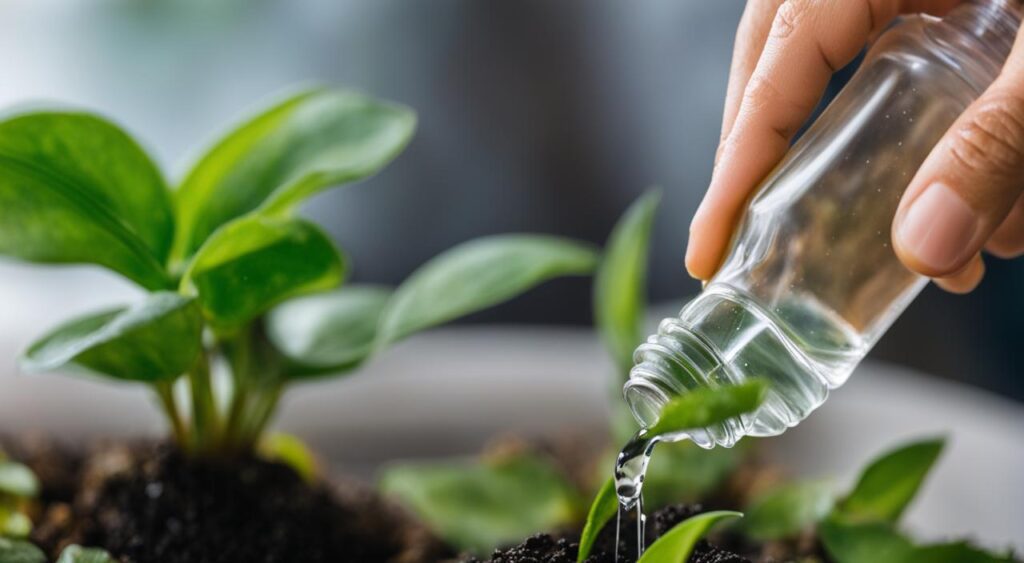
Anubias Nana, including the Anubias barteri var. nana species, is a slow grower that does not require frequent or heavy fertilization. In fact, excessive nutrient levels can lead to algae growth on the leaves of the plant. To keep Anubias Nana healthy and thriving, it is sufficient to provide regular water changes and a balanced fish waste-based diet that naturally enriches the water with nutrients.
Unlike other plants that may benefit from added fertilizers, Anubias Nana obtains most of its nutrients from the water column, making it less dependent on substrate fertilization. This plant has a robust root system called a rhizome that can absorb nutrients efficiently.
Notably, Anubias Nana is sensitive to high nitrate levels, which can lead to stunted growth and algae issues. Therefore, maintaining proper water quality through regular water changes is crucial for plant health.
Following a regular maintenance routine, including adequate water changes and a balanced fish waste-based diet, ensures that your Anubias Nana thrives without additional fertilization.
CO2 Injection
Anubias Nana is a low-light plant that can thrive in aquariums without adding CO2 injection. It is capable of growing well with normal ambient CO2 levels. However, some aquarists choose to supplement CO2 in order to promote faster growth and develop more robust leaves. Various types of CO2 injection systems are available, including pressurized CO2 and liquid carbon supplements.
Care
Planted Tank Parameters
Creating the ideal environment for your Anubias Nana is essential for its health and growth. The planted tank parameters are crucial in providing the right conditions for this beginner-friendly aquarium plant.
Anubias Nana thrives in slightly acidic to neutral pH levels ranging from 6 to 7.5. Maintaining stable water parameters is vital for the well-being of the plant.
The recommended temperature range for Anubias Nana is between 72 and 82°F, which is suitable for most tropical aquarium setups. Ensure that the water temperature remains within this range to support optimal growth.
Water Quality
Good water quality is vital for the success of Anubias Nana in your aquarium. Regular water changes are necessary to prevent the buildup of harmful substances and maintain optimal water conditions.
Monitor the water parameters regularly, including ammonia, nitrite, nitrate, and pH levels, to ensure they are within the acceptable range. High ammonia and nitrite levels can be toxic to Anubias Nana, while excessive nitrate can promote unwanted algae growth.
Filtration
A reliable filtration system is crucial for maintaining water clarity and removing debris that may clog the plant’s leaves. Anubias Nana benefits from a moderate flow rate, as it helps distribute nutrients and oxygen to the plant while preventing stagnant areas.
Choose a filter suitable for your aquarium size and consider using filter media that promote biological filtration, such as ceramic rings or bio-balls. Regular cleaning and maintenance of the filter will ensure its effectiveness in providing optimal water conditions.
Flow
Anubias Nana prefers gentle water flow in the aquarium. Strong currents can damage the delicate leaves of the plant and hinder its growth. Consider adjusting the flow rate of your aquarium filter or positioning the plant in an area with reduced water movement.
| Planted Tank Parameters | Water Quality | Filtration | Flow |
|---|---|---|---|
| Slightly acidic to neutral pH (6-7.5) | Regular water changes | Reliable filtration system | Gentle water flow |
| Temperature range: 72-82°F | Monitor water parameters | Use filter media for biological filtration | Avoid strong currents |
By providing the right planted tank parameters, maintaining good water quality, using appropriate filtration, and ensuring gentle water flow, you can create an optimal environment for the health and well-being of Anubias Nana in your aquarium.
Aquarium Maintenance
Testing Water Conditions
Regular testing of water conditions is crucial for the health and growth of Anubias Nana. Monitoring the water parameters ensures that the aquarium environment suits the plant’s optimal growth. Important water parameters to test include pH levels, ammonia, nitrite, nitrate, and temperature.
Using a reliable test kit, you can quickly check the water conditions in your aquarium. Follow the instructions provided with the test kit and record the results for future reference. Based on the test results, adjustments can be made to maintain the ideal water parameters for Anubias Nana.
How To Set Up Your Aquarium Tank
Properly setting up your aquarium tank is crucial for the long-term success of Anubias Nana. Follow these steps to ensure a suitable environment for the plant:
- Select the right aquarium size based on the number of plants and fish you plan to keep. A larger tank provides more stability and allows for better water quality maintenance.
- Choose a suitable substrate. Anubias Nana can be attached to rocks or driftwood, so gravel or sand substrate may not be necessary. However, a nutrient-rich substrate can promote overall plant health.
- Position the hardscape elements, such as rocks and driftwood, in a visually appealing arrangement. This will serve as anchor points for attaching Anubias Nana.
- Install an appropriate lighting system. Anubias Nana is a low-light plant, so choose a light fixture that provides adequate illumination without causing excessive algae growth.
- Set up the filtration system to maintain good water quality. Anubias Nana prefers gentle water flow, so adjust the filter’s flow rate if needed.
- Cycle the aquarium before adding Anubias Nana. This will establish a healthy nitrogen cycle and create a stable environment for the plant.
Propagation Methods
Anubias Nana can be propagated through various methods, allowing you to expand your collection or share the plant with others. The most common propagation method for Anubias Nana is separating rhizomes and replanting them in the aquarium.
To propagate Anubias Nana, follow these steps:
- Gently remove the plant from the aquarium, careful not to damage the rhizome or roots.
- Identify a healthy rhizome with several leaves and roots.
- Carefully separate the rhizome into multiple sections using clean scissors or a sharp knife. Each section should have at least a few leaves and healthy roots.
- Replant the separated rhizomes in the desired locations in the aquarium. Ensure that the rhizomes are not buried but instead attached to a hardscape element or left exposed.
- Provide appropriate care and maintenance to the newly propagated Anubias Nana to support its growth and establishment in the aquarium.
Propagation of Anubias Nana can be a rewarding process, allowing you to create more lush greenery in your aquarium and share the beauty of this plant with others.
Health And Disease
Signs of Good Health
Maintaining good water quality and providing appropriate care are essential for the health of Anubias Nana. Signs of good health include vibrant green leaves, new growth, and the absence of algae or pests. When Anubias Nana is healthy, it will exhibit strong and well-formed leaves, demonstrating its ability to photosynthesize and thrive in its aquatic environment.
Signs of Poor Health
It’s important to monitor the health of your Anubias Nana plants to address any potential issues promptly. Signs of poor health may include yellowing or browning leaves, stunted growth, or excessive algae growth on the leaves. These signs can indicate nutrient deficiencies, improper lighting, or other issues affecting the plant’s well-being. Prompt intervention and adjustments to care can help prevent further deterioration.
Common Health Issues and Treatment
Anubias Nana might encounter various health issues affecting its growth and overall condition. Nutrient deficiencies, particularly iron and potassium, can cause yellowing leaves or poor growth. Adding appropriate fertilizers or liquid supplements can help address these deficiencies. Another common issue is algae growth. This can be controlled by maintaining proper nutrient levels, reducing lighting duration, and manually removing algae from the leaves. Snail infestations can also occur, damaging the plant’s leaves. Regular manual removal or introduction of snail-eating fish can help manage this issue.
Plant Pests
Anubias Nana might attract common plant pests, including snails, aphids, and planaria. Snails can consume and damage the leaves, while aphids sap the plant’s nutrients and weaken its health. Planaria, small flatworms, can also be problematic. Physical removal, introducing natural predators, or using appropriate pest control treatments can help manage these pests and maintain a healthy plant environment.
| Common Health Issues | Treatment |
|---|---|
| Nutrient deficiencies (e.g., iron, potassium) | Provide appropriate fertilizers or liquid supplements |
| Algae growth on leaves | Maintain proper nutrient levels, reduce lighting duration, and manually remove algae. |
| Snail infestations | Regular manual removal or introduce snail-eating fish |
| Other pests (e.g., aphids, planaria) | Physical removal, introducing natural predators or using of appropriate pest control treatments. |
Summary
Anubias Nana, also known as Anubias barteri var. nana, is popular among aquarists for its ease of care, hardiness, and compatibility with various fish species. This low-light aquarium plant is a slow grower, making it perfect for beginners looking for a low-maintenance option.
Anubias Nana can be placed in the midground or background of the aquarium, adding beauty and greenery to any setup. Its broad, lance-shaped leaves are dark green and can grow up to 3 inches long. The plant is adaptable to a wide range of water parameters, thriving in slightly acidic to neutral pH and temperatures between 72-82°F.
Proper care and maintenance of Anubias Nana are essential for its health and growth. It does not require frequent fertilization, as it can derive sufficient nutrients from regular water changes and a balanced fish waste-based diet. While CO2 injection is not necessary, some aquarists choose to supplement CO2 for more rapid growth.
In summary, Anubias Nana is a versatile and beginner-friendly aquarium plant that can thrive in low-light conditions. With its hardiness, compatibility with various fish species and attractive foliage, this plant is an excellent addition to any aquarium setup.
FAQ
What is Anubias Nana?
Anubias Nana, also known as Anubias barteri var. nana, is a popular variety of the Anubias plant that is commonly used in aquariums.
Is Anubias Nana a slow-growing plant?
Yes, Anubias Nana is a slow-growing plant that can thrive in both aquariums and terrariums.
Where is Anubias Nana native to?
Anubias Nana is native to West Africa, where it can be found growing in rivers, streams, and marshes.
What are the characteristics of Anubias Nana?
Anubias Nana has broad, lance-shaped leaves that are dark green in color. There are also several varieties of Anubias Nana with different leaf shapes and sizes.
Where should I place Anubias Nana in my aquarium?
Anubias Nana can be placed in the midground or background of the tank, attached to rocks, driftwood, or other hardscape elements.
What are good tank mates for Anubias Nana?
Anubias Nana is compatible with small to medium-sized community fish, dwarf cichlids, and some shrimp species. Good tank mates include tetras, rasboras, gouramis, and plecos.
Does Anubias Nana require fertilization?
Anubias Nana does not require heavy fertilization. Regular water changes and a balanced fish waste-based diet are sufficient for its nutritional needs.
Does Anubias Nana require CO2 injection?
Anubias Nana can grow well without CO2 injection, but some aquarists choose to supplement CO2 to promote faster growth.
How should I care for Anubias Nana?
Anubias Nana thrives in slightly acidic to neutral pH and temperatures between 72-82°F. Good water quality, proper filtration, and gentle water flow are important for its health and growth.
How do I maintain my Anubias Nana aquarium?
Regular aquarium maintenance, including testing water conditions, proper tank setup, and propagation methods, is important for the health and growth of Anubias Nana.
What are the signs of good health for Anubias Nana?
Signs of good health include vibrant green leaves, new growth, and absence of algae or pests.
What are the common health issues for Anubias Nana?
Common health issues for Anubias Nana include nutrient deficiencies, algae growth, and snail infestations.
How can I summarize Anubias Nana?
Anubias Nana is a popular choice among aquarists due to its ease of care, hardiness, and compatibility with a wide range of fish species.

